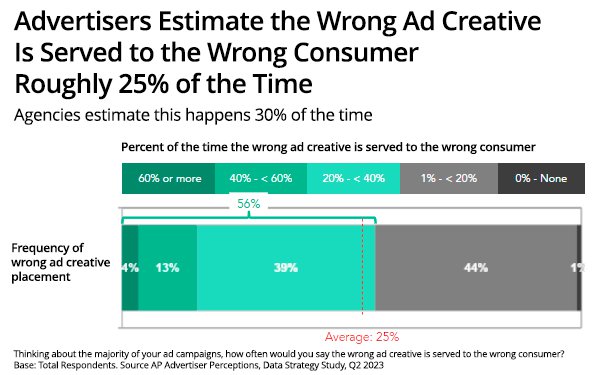by Laurie Sullivan , Staff Writer @lauriesullivan
Source: www.mediapost.com, October 2023
Agencies report that the wrong ad creative is served to the wrong consumer nearly one in every three times, according to new research.
The joint study from Advertiser Perceptions and Claravine fielded in August analyzed the impact of not having a data standards and a strategy in place. It showed how advertisers and agencies struggle with brand safety and in the process, found a connecting line between data standards, brand safety and ad targeting.
Despite living in a world where real-time dynamic advertising is possible, the study shows that about half of the 140 U.S. advertisers surveyed would not know that an ad ran next to unsuitable or unsafe content until a day or more later. The survey went to strategy leaders, operations professionals, and those in a data and analytics role.
Teams that implemented data standards reported the ability to identify these mistakes much faster than their counterparts who did not have standards in place, and saw a direct increase in ROI of about 30%.
Lauren Fisher, vice president of business intelligence at Advertiser Perceptions, said those who already implemented a data-standard strategy approached aspects of their advertising, marketing and organizational structure.
“We found that marketers who had implemented data standards had more confidence in their ability to understand the data influencing advertising performance, being able to measure down to the individual campaign or creative, and had a better handle on some of the processes across the organization with the sharing of data,” Fisher said.
The data shows that 29% of respondents believe that the highest risk in brand safety and poor visibility points to organizational inefficiencies to measuring campaigns. Others include brand safety, presenting consumers with conflicting messages.
Marketers with standards practices in place see a 30% on average return on investment increase across practices such as privacy compliance, productivity, managing campaign return on investment ROI, ad-creative development, brand safety and consumer experience.
But lack of standardization in data, creative and reporting makes it difficult for advertisers to combine data to create audience segments, deploy data and ad creative or combine reporting for greater measurement insight.
Lack of reporting standardization is the top perceived challenge when advertisers look to tie ROI to data sets. Analytics teams are significantly more likely to struggle with lack of consistency in naming conventions across platforms and teams to be able to trust the data, and lack of access to data that is needed or formatted in the way that is needed.
Some 58% of survey participants said the complexity of integrating systems and data sets is the biggest hurdle to implementing data standards practices, followed by the 44% who cite the length of time to see any return on investment. About 43% point to data silos that make it difficult to identify necessary data sets.
There are other factors. Some 36% cite cost of hiring outside help to facilitate implementation, 34% cite lack of alignment across the organization, 34% point to lack of education on how to execute a strategy, and 30% point to the lack of internal talent to execute plan.
Chris Comstock, chief growth officer at Claravine, said: “It’s a go, go, go mindset and many do not take the time to determine what it takes to get the organization aligned on one strategy because they are running from campaign to campaign.”
Proving value is a challenge. The inability to prove ROI and lack of internal resources are major reasons why organizations have not implemented data-standard practices.
Fifty-four percent pointed to the inability to prove value; 51%, lack internal resources to execute a plan; 40%, perceived cost of execution; 35%, the belief that practices and standards are not necessary; and 20% say it’s not a priority for the organization.

